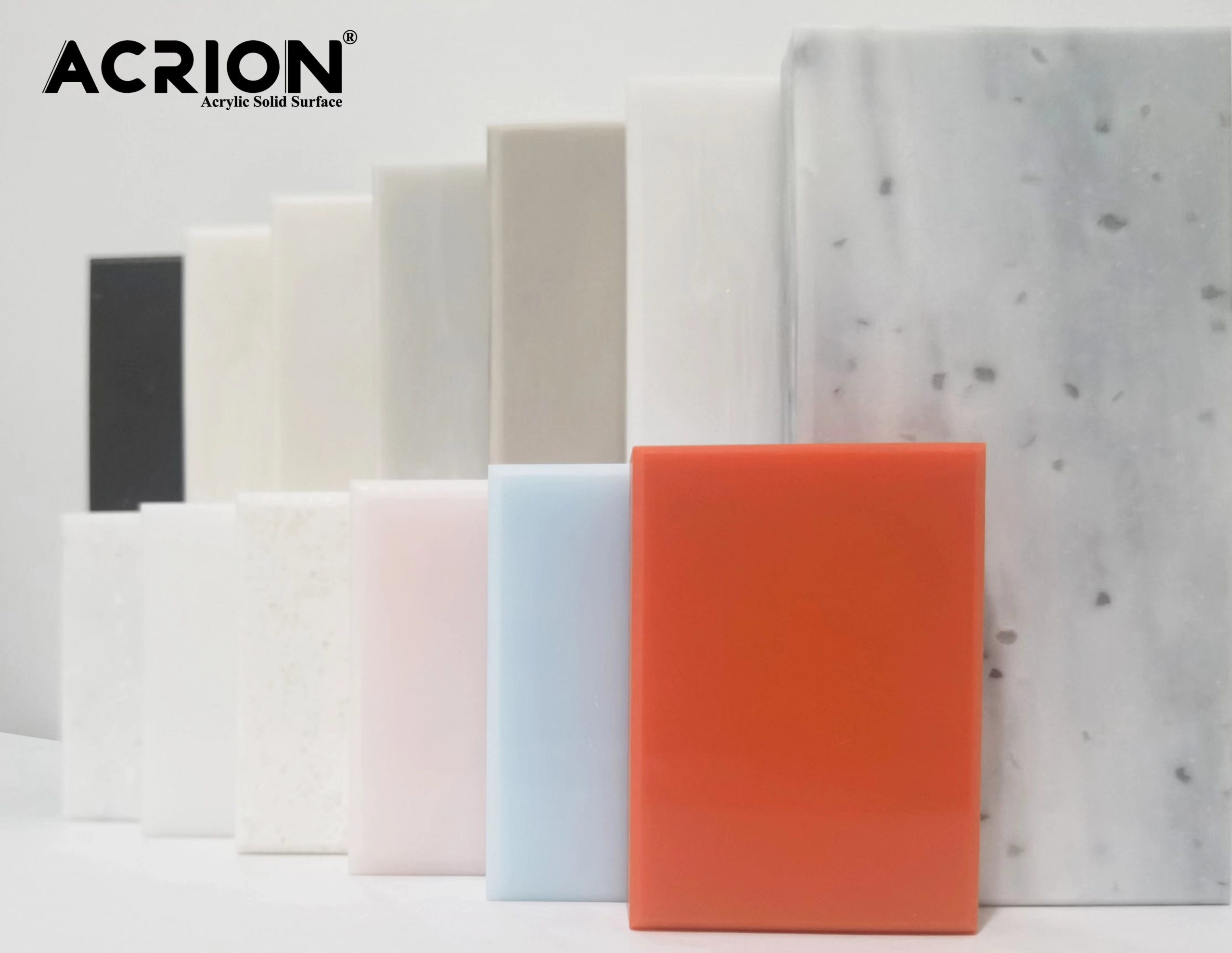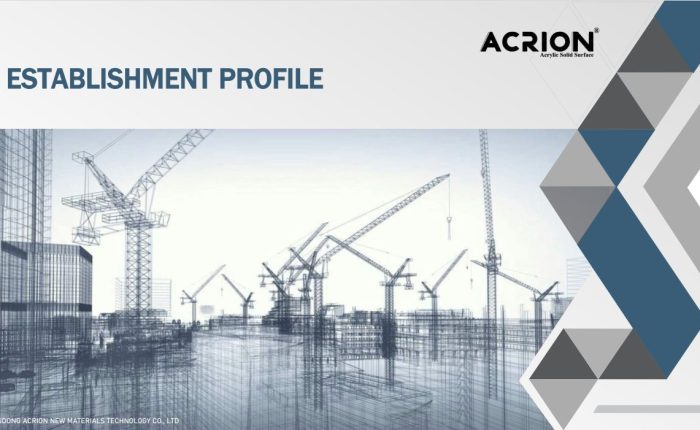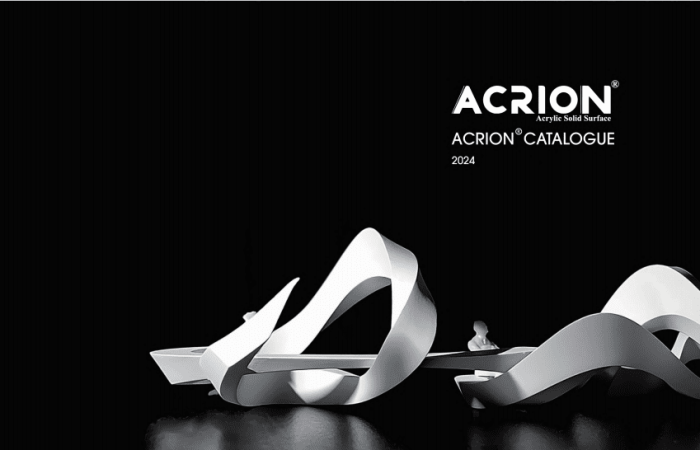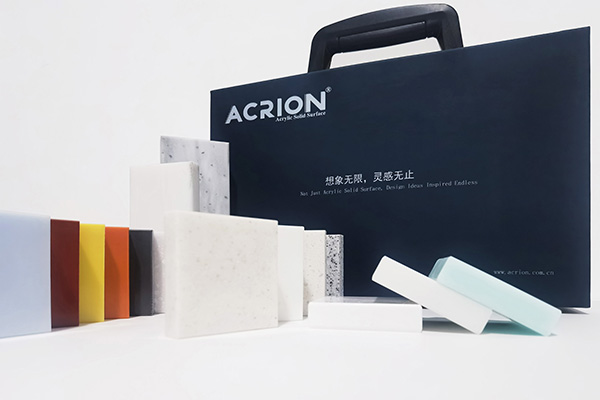فهم معايير اختبار السطح الصلب: الأداء ، الشهادات ، والمعايير العالمية
عند اختيار مادة سطحية صلبة للتصميمات الداخلية التجارية أو مرافق الرعاية الصحية أو المطابخ السكنية ، فإن فهم أدائها هو أكثر من مجرد فضول فني - إنه عامل قرار حاسم. ولكن ما الذي يحدد سطحًا صلبًا عالي الجودة؟ كيف يمكننا قياس المتانة أو استقرار الألوان أو المقاومة الكيميائية أو السلامة؟
يستكشف هذا الدليل الشامل معايير الاختبار العالمية التي تحكم المواد السطحية الصلبة - مثل ASTM D638 لقوة الشد ، ASTM G155 للأشعة فوق البنفسجية ، Ansi Z124.3 لمقاومة السطح ، و ISO 11341 من أجل ثبات اللون. هذه المعايير ليست مجرد أرقام فنية ؛ وهي تعكس كيفية أداء السطح في بيئات العالم الحقيقي-معرضة للحرارة والضوء والبقع والتأثيرات والوقت.
من خلال هذه المقالة ، سوف نسير لك عبر الشهادات الأساسية ، وعتبات الأداء ، وطرق الاختبار التي تهم أكثر في صناعة السطح الصلب. سوف تكتشف أيضًا كيف Acrion® يتم اختبار المواد والتحقق من صحتها لتلبية هذه المعايير الصارمة أو تجاوزها UV المستقر ، يتلاشى مقاوم ، آمن من الطعام حلول مصممة للأسطح الحديثة.
سواء كنت مصممًا أو مهندسًا معماريًا أو مصنعًا أو مجرد تعلم الجانب الفني لتوضيح الأكريليك ، ستساعدك هذه الصفحة على اتخاذ قرارات مستنيرة بوضوح وثقة.
تصنيف معايير اختبار السطح الصلب
يتم تقييم المواد السطحية الصلبة من خلال مجموعة واسعة من الاختبارات الموحدة - كل منها مصمم لتقييم جانب معين من الأداء أو المتانة أو السلامة. عادة ما يتم تصنيف هذه الاختبارات إلى أربع فئات رئيسية: القوة الميكانيكيةو المقاومة الكيميائيةو قابلية الطقس، و صحة & الشهادات البيئية.
يوفر فهم هذه الفئات إطار عمل لمقارنة المواد عبر العلامات التجارية والأسواق. فيما يلي نظرة عامة على كيفية تطبيق كل فئة ومعايير يتم تطبيقها بشكل شائع:
| فئة | غاية | المعايير الرئيسية |
|---|---|---|
| 1. الأداء الميكانيكي | يقيم القوة البدنية والمرونة والصلابة والاستقرار الأبعاد | ASTM D638 ، ASTM D790 ، ASTM D785 ، ASTM D648 |
| 2. المواد الكيميائية & مقاومة السطح | يقيم مقاومة تلطيخ وعوامل التنظيف وحروق السجائر والمواد الكيميائية المنزلية | ANSI Z124.3 ، ISO 19712-3 ، CSA B45.5-11 |
| 3. قابلية الطقس & استقرار اللون | يحاكي التعرض طويل الأجل للأشعة فوق البنفسجية والحرارة والرطوبة لتقييم تغيير اللون (ΔE) | ASTM G155, ISO 11341, JIS K 6902, JIS K 6911 |
| 4. الصحة والسلامة & البيئة | يتحقق | NSF 51 ، ASTM E84 ، EN 13501-1 ، UL 2818 (Greenguard) |
تلعب كل مجموعة من مجموعات الاختبار هذه دورًا حيويًا في تحديد مدى ملاءمة سطح صلب لتطبيقات محددة-سواء أكان ذلك في مستشفى معقم ، أو مطبخ مشمس ، أو كونترتوبًا تجاريًا عالي الحركة. ستقوم الأقسام التالية بتفكيك المعايير الفردية وما تعنيه النتائج لمشاريعك.
أوضحت معايير الاختبار الرئيسية
الآن بعد أن قمنا بتصنيف مجالات الأداء الأساسية لتقييم السطح الصلب ، دعنا نستكشف معايير المفاتيح المستخدمة في كل فئة. هذه الأساليب الموحدة - التي تعتبرها منظمات مثل ASTM International و ISO و ANSI - تفيد بأن مطالبات الأداء قابلة للقياس وقابلة للمقارنة وموثوق بها عبر الصناعات.
1. الأداء الميكانيكي: القوة والمرونة والاستقرار
تحدد الخصائص الميكانيكية قدرة سطح صلب على تحمل الإجهاد والتأثير والتشوه الحراري. هذه القيم حاسمة في كل من التصنيع والمتانة على المدى الطويل. تخضع منتجات السطح الصلبة لـ Acrion لبطارية من الاختبارات الميكانيكية ASTM ، بما في ذلك:
- ASTM D638 - قوة الشد: يقيس الحد الأقصى للضغط الذي يمكن أن تحمله العينة عند تفكيكه. يسجل Acrion قوة شد 43.1 ميجا باسكال، ضمان النزاهة الهيكلية القوية.
- ASTM D790 - قوة الانحناء: يقيم قوة الانحناء للمادة. Acrion يحقق 72.2 ميجا باسكال، مناسبة للتطبيقات الكابولي مثل الرفوف أو كونترتوب الممتدة.
- ASTM D785 - صلابة Rockwell: يحدد صلابة السطح. وصول Acrion 94.6 على مقياس M، مقاومة الخدوش والمسافة البادئة.
- ASTM D648 - درجة حرارة تشويه الحرارة: يختبر درجة الحرارة التي تتشوه فيها المواد تحت الحمل. نتيجة Acrion هي 111.5 درجة مئوية، إظهار الاستقرار الحراري الجيد.
تحدد هذه المعايير مجتمعة مدى جودة المواد وتشكيلها واستخدامها تحت الإجهاد في كل من البيئات السكنية والتجارية.
2. المواد الكيميائية & مقاومة السطح: الدفاع ضد البقع والأضرار
تتعرض الأسطح الصلبة لمجموعة متنوعة من الملوثات وعوامل التنظيف. يضمن اختبار المقاومة الكيميائية أن المواد لا تتأثر بالقهوة والنبيذ وزيوت الطعام ومستحضرات التجميل والمذيبات الصناعية.
- Ansi Z124.3: يتضمن هذا المعيار في أمريكا الشمالية اختبارات لمقاومة البقع ، ومقاومة حرق السجائر ، والتنظيف ، والتآكل. يجتاز Acrion جميع اختبارات مقاومة السطح ، وتلبية متطلبات الفئة الأولى.
- ISO 19712-3: المعيار الأوروبي مع التركيز على المقاومة الكيميائية والبقع. يتم اختبار المواد ضد 49 وكيل ، بما في ذلك الأسيتون ، هيدروكسيد الصوديوم ، واليود. وسجل Acrion الصف 5 (لا يوجد تغيير واضح) في معظم الفئات.
- CSA B45.5-11 / IPMS Z124: المعيار الكندي/الأمريكي المركب الذي يشمل المقاومة الحرارية والكيميائية لتركيبات السباكة. Acrion يمر هذا المعيار لاستخدام الحمام/المطبخ.
تؤكد هذه التقييمات على المصممين والمستخدمين النهائيين أن مواد Acrion ستحافظ على الأداء الجمالي والصحية في بيئات عالية الاستخدام مثل الرعاية الصحية والضيافة والخدمة الغذائية.
3. قابلية الطقس & استقرار اللون: محاربة الأشعة فوق البنفسجية والحرارة والوقت
يعد استقرار الألوان أحد أهم العوامل في المنشآت طويلة الأجل ، وخاصة للمطابخ المعرضة للشمس أو العدادات الخارجية أو عروض البيع بالتجزئة. اختبارات الطقس تحاكي سنوات من التعرض في بيئة خاضعة للرقابة.
- ASTM G155: يستخدم مصابيح قوس زينون لتقليد أشعة الشمس والرطوبة. اختبارات Acrion ل 1000 ساعة من التعرض للأشعة فوق البنفسجية ، والحفاظ Δe*94 < 8- التغلب على طفيفة دون تغيير ملحوظ.
- ISO 11341: على غرار G155 ، ولكن منظم تحت تنسيق ISO ؛ يحسب أيضا ΔE بمرور الوقت. يتحقق هذا الاختبار معايير المتانة العالمية للمواد المعمارية.
- JIS K 6902 / K 6911: المعايير اليابانية التي تقيس الاحتفاظ اللامع والتغير الحراري وهجاء المواد تحت الإجهاد بالأشعة فوق البنفسجية/الحرارية.
تحدد قيم ΔE تغيير اللون: أقل من 1 غير محسوس ، 1-3 بالكاد ملحوظة ، وما فوق 5 يشير إلى تلون مرئي. تضمن الصيغ المستقر للأشعة فوق البنفسجية من Acrion جاذبية بصرية دائمة عبر سنوات من الاستخدام.
4. الصحة والسلامة & المعايير البيئية: الأداء المتمحور حول الإنسان
إلى جانب المتانة والمظهر ، يجب أن تكون المنتجات السطحية الصلبة آمنة - بالنسبة للأشخاص والبيئة. الشهادات التحقق من صحة أن المواد آمنة للأغذية ، مقاومة للهب ، ومنخفضة في الانبعاثات.
- NSF/ANSI 51: يشهد مواد للاتصال الغذائي في المساحات العامة. Acrion متوافق ومناسبة للمطابخ والمختبرات والأسطح الطبية.
- ASTM E84: تدابير انتشار اللهب وتنمية الدخان. Acrion يحقق الفئة أ- أعلى تصنيف للسلامة من الحرائق لمواد البناء.
- في 13501-1: تصنيف الحريق الأوروبي ؛ درجات acrion B-S1 ، D0، وهذا يعني محدودة للغاية الاحتراق والدخان.
- UL 2818 (GreenGuard / Gold): اختبارات للمركبات العضوية المتطايرة (TVOCs). Acrion معتمد منخفض الانبعاثات ويساهم في جودة الهواء الداخلي أكثر صحة.
لا تلبي هذه الشهادات متطلبات الامتثال فحسب ، بل تعزز أيضًا أهلية المشروع لبرامج البناء الخضراء مثل LEED و Well و Breeam.
الأفكار النهائية: لماذا تحدد معايير الاختبار الجودة
في سوق الإنشاءات المنظم بشكل متزايد ويعتمد على الأداء ، لم يعد فهم معايير اختبار السطح الصلبة اختياريًا-إنه ضروري. من قوة الشد ومقاومة وصمة عار إلى استقرار اللون والسلامة في الهواء الداخلي ، تخدم كل شهادة دورًا عمليًا في ضمان أداء موادك بشكل موثوق وأمان وجميل بمرور الوقت.
تم تصميم الأسطح الصلبة Acrion® ليس فقط للالتقاء - ولكن لتجاوز - معايير global مثل ASTM G155و ISO 11341و Ansi Z124.3، و NSF/ANSI 51. تعكس عمليات التحقق هذه التزامنا بتكامل المنتج والتميز الفني والقيمة طويلة الأجل للمهندسين المعماريين والمصممين والمستخدمين النهائيين على حد سواء.
كشركة مصنعة ، نحن نؤمن بالشفافية الكاملة. لهذا السبب ندعوك لاستكشاف مجموعتنا الكاملة من مواد سطحية صلبة معتمدة، وصول أوراق البيانات والتقارير الفنية، أو اتصل بأخصائياتنا لوثائق الاختبار الخاصة بالمشروع.
سواء كنت تحدد أسطحًا لمختبر طبي أو مطبخ مملوء بالشمس أو الغرور الفاخر في الفندق-يبدأ الأداء بإثبات. مع Acrion® ، أنت مدعوم بالبيانات ، مدعومة بالاختبار ، وتمكينها من خلال الثقة.



